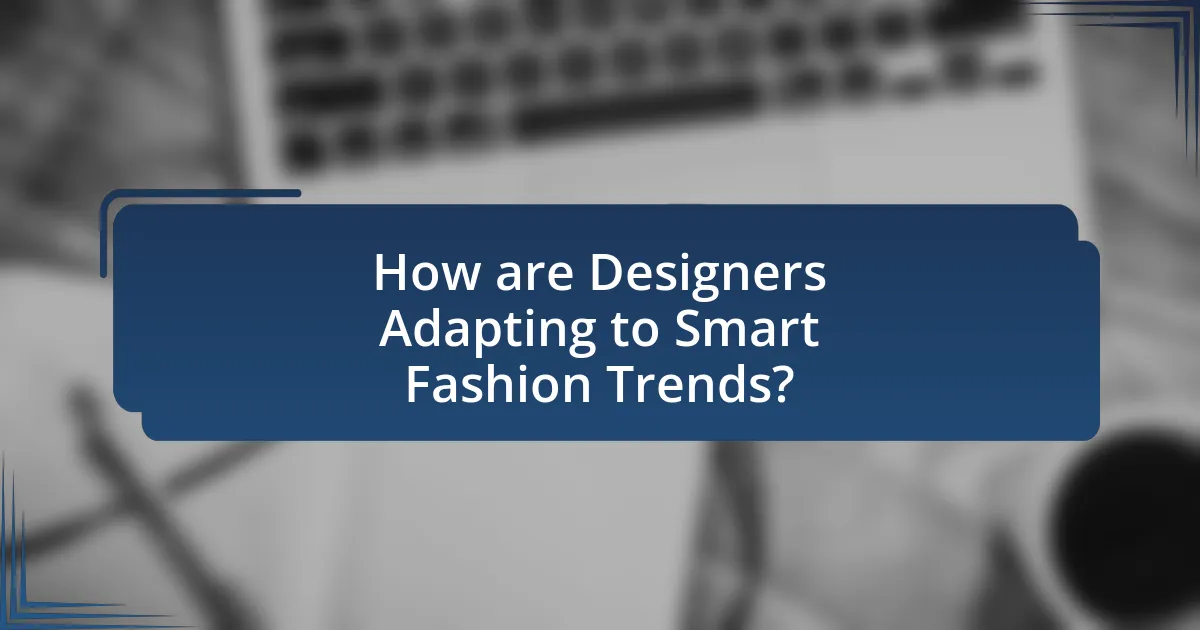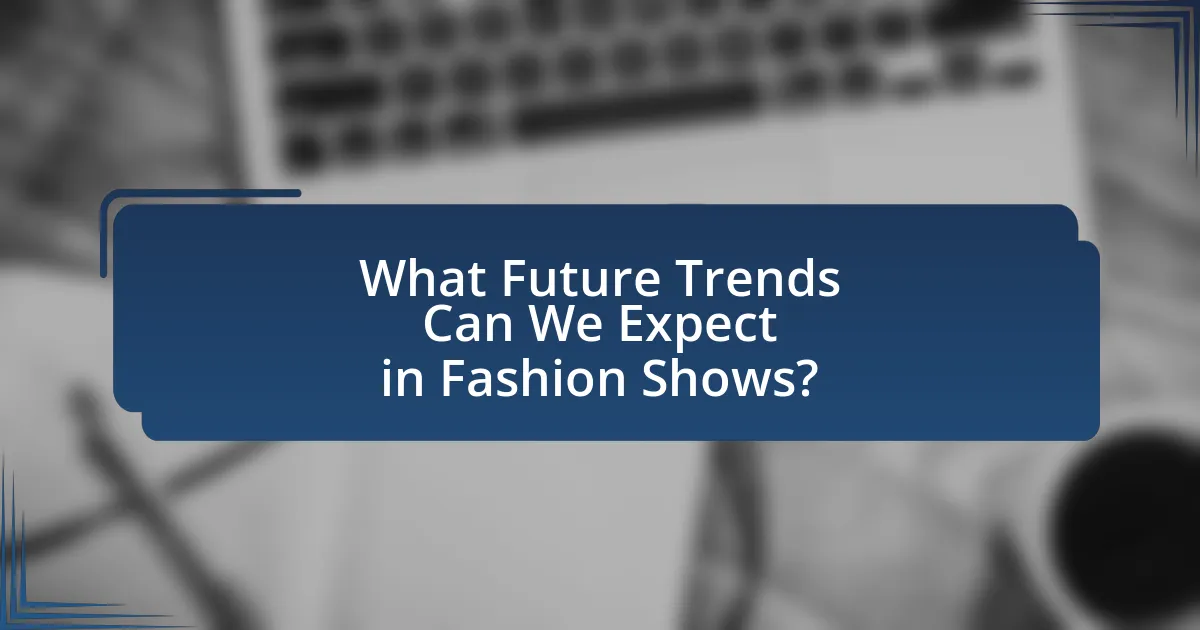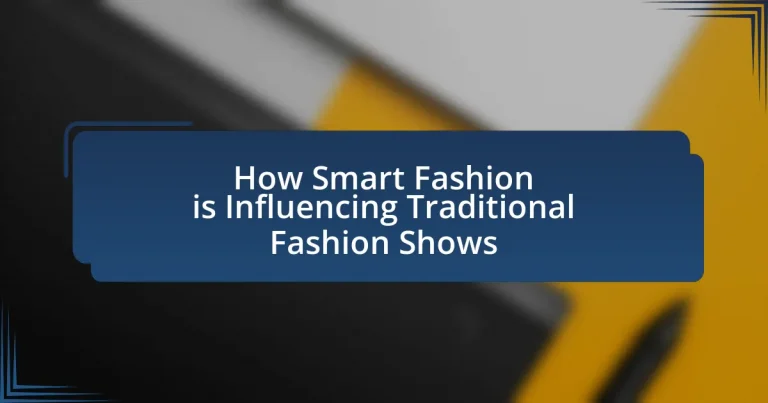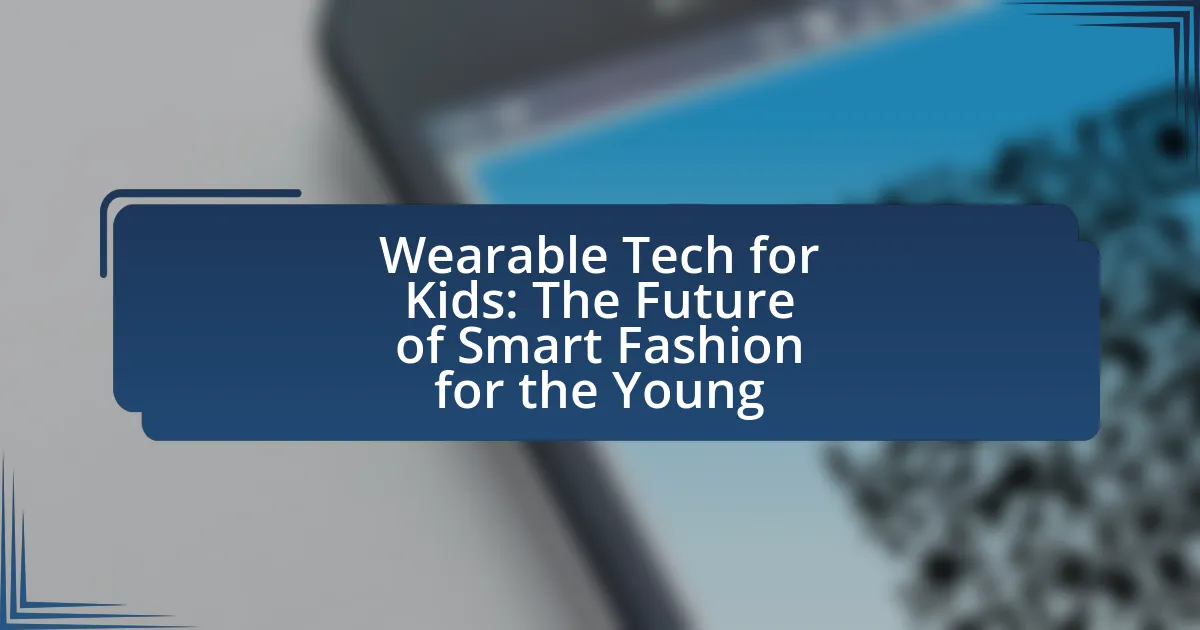Smart fashion is transforming traditional fashion shows by incorporating advanced technologies such as augmented reality (AR), virtual reality (VR), and smart textiles, enhancing audience engagement and presentation dynamics. Key characteristics of smart fashion include sustainability, personalization, and the integration of wearable technology, which collectively redefine consumer interaction and production methods. The evolution of fashion shows is driven by changing consumer expectations, the demand for inclusivity, and the need for sustainable practices, prompting designers to adapt by merging innovation with traditional aesthetics. As technology continues to influence fashion presentations, emerging trends indicate a shift towards more immersive, interactive, and eco-friendly experiences in the fashion industry.

How is Smart Fashion Redefining Traditional Fashion Shows?
Smart fashion is redefining traditional fashion shows by integrating technology to enhance the presentation and experience of fashion. This integration includes the use of augmented reality (AR) and virtual reality (VR), allowing designers to create immersive environments that engage audiences in novel ways. For instance, brands like Balenciaga have utilized VR to showcase collections in virtual spaces, enabling viewers to experience the fashion in a more interactive manner. Additionally, smart textiles and wearable technology are being incorporated into runway designs, showcasing garments that can change color or display digital patterns, thus merging fashion with functionality. This shift not only attracts tech-savvy consumers but also challenges conventional notions of fashion presentation, making shows more dynamic and accessible.
What are the key characteristics of Smart Fashion?
Smart Fashion is characterized by its integration of technology, sustainability, and personalization. The incorporation of wearable technology, such as smart textiles and connected devices, allows garments to interact with users and their environments. Sustainability is emphasized through eco-friendly materials and ethical production practices, addressing the environmental impact of the fashion industry. Personalization is achieved through data-driven insights, enabling customized designs and fits that cater to individual consumer preferences. These characteristics collectively redefine consumer engagement and production methods in the fashion industry.
How does technology integrate into Smart Fashion?
Technology integrates into Smart Fashion through the incorporation of wearable devices, smart textiles, and data analytics. Wearable devices, such as smartwatches and fitness trackers, provide real-time data on user activity and health metrics, influencing design and functionality in fashion. Smart textiles, embedded with sensors and conductive materials, enable garments to respond to environmental changes or user interactions, enhancing user experience. Data analytics plays a crucial role by analyzing consumer behavior and preferences, allowing designers to create personalized and trend-responsive collections. For instance, the global smart clothing market is projected to reach $5.3 billion by 2024, highlighting the growing impact of technology in fashion.
What materials are commonly used in Smart Fashion?
Smart Fashion commonly utilizes materials such as conductive textiles, smart fabrics, and e-textiles. Conductive textiles integrate conductive fibers that enable electronic functionalities, while smart fabrics can respond to environmental stimuli, such as temperature or moisture. E-textiles often incorporate sensors and microcontrollers, allowing garments to collect data or interact with other devices. These materials are essential in creating innovative clothing that merges technology with fashion, enhancing user experience and functionality.
Why are traditional fashion shows evolving?
Traditional fashion shows are evolving due to the integration of technology and changing consumer expectations. The rise of digital platforms and social media has shifted how brands showcase their collections, allowing for more interactive and accessible presentations. For instance, live-streaming of shows and virtual reality experiences have become common, enabling global audiences to engage with fashion in real-time. Additionally, the demand for sustainability and inclusivity is prompting designers to rethink traditional formats, leading to more diverse models and eco-friendly practices. This evolution reflects the industry’s response to a more connected and socially conscious consumer base, as evidenced by the increasing number of brands adopting digital-first strategies and sustainable initiatives.
What challenges do traditional fashion shows face today?
Traditional fashion shows face significant challenges today, primarily due to the rise of digital platforms and changing consumer behaviors. The shift towards online viewing has diminished the exclusivity and allure of in-person shows, as brands increasingly opt for virtual presentations to reach broader audiences. Additionally, sustainability concerns are prompting a reevaluation of the resource-intensive nature of traditional shows, which often involve extensive travel and waste. According to a 2021 McKinsey report, 67% of consumers are more likely to purchase from brands that demonstrate sustainable practices, highlighting the need for fashion shows to adapt to these expectations. Furthermore, the COVID-19 pandemic has accelerated the adoption of digital formats, forcing traditional shows to compete with innovative online experiences that engage audiences in new ways.
How is audience engagement changing in fashion shows?
Audience engagement in fashion shows is evolving through the integration of technology and interactive experiences. Traditional passive viewing is being replaced by immersive participation, where audiences can engage with the show via social media, live streaming, and augmented reality. For instance, brands like Balenciaga and Gucci have utilized digital platforms to allow viewers to interact with collections in real-time, enhancing their connection to the brand. This shift is supported by a 2022 report from McKinsey, which indicates that 70% of consumers prefer brands that offer interactive experiences.
What role does sustainability play in Smart Fashion?
Sustainability plays a crucial role in Smart Fashion by promoting eco-friendly practices and reducing environmental impact. Smart Fashion integrates technology to enhance sustainable practices, such as using biodegradable materials, minimizing waste through digital design, and optimizing supply chains for efficiency. For instance, a report by McKinsey & Company highlights that the fashion industry is responsible for 10% of global carbon emissions, emphasizing the need for sustainable solutions. By adopting smart technologies, brands can track their environmental footprint and make informed decisions that align with sustainability goals, ultimately transforming traditional fashion shows into platforms that prioritize ecological responsibility.
How does Smart Fashion address environmental concerns?
Smart Fashion addresses environmental concerns by utilizing sustainable materials and innovative production techniques that minimize waste. For instance, brands often incorporate recycled fabrics and biodegradable materials, which significantly reduce the environmental footprint associated with traditional fashion manufacturing. Additionally, Smart Fashion promotes a circular economy through practices such as upcycling and rental services, which extend the lifecycle of garments and decrease the demand for new resources. This approach is supported by research indicating that the fashion industry contributes to 10% of global carbon emissions, highlighting the urgent need for sustainable practices.
What are the benefits of sustainable practices in fashion shows?
Sustainable practices in fashion shows provide environmental benefits, enhance brand reputation, and promote ethical consumerism. By reducing waste and utilizing eco-friendly materials, fashion shows can significantly lower their carbon footprint, contributing to a healthier planet. For instance, a study by the Fashion Institute of Technology found that sustainable practices can reduce waste by up to 90% compared to traditional methods. Additionally, brands that adopt sustainable practices often experience increased consumer loyalty, as modern consumers are increasingly prioritizing ethical considerations in their purchasing decisions. This shift not only fosters a positive brand image but also encourages the fashion industry to move towards more responsible practices.

How are Designers Adapting to Smart Fashion Trends?
Designers are adapting to smart fashion trends by integrating technology into their designs, such as using wearable tech and smart textiles. This integration allows for enhanced functionality, like health monitoring and interactive features, which appeal to tech-savvy consumers. For instance, brands like Ralph Lauren have developed smart shirts that track biometric data, showcasing how traditional fashion can merge with innovative technology. Additionally, designers are increasingly collaborating with tech companies to create garments that not only serve aesthetic purposes but also provide practical benefits, reflecting a shift in consumer expectations towards multifunctional clothing.
What strategies are designers using to incorporate Smart Fashion?
Designers are incorporating Smart Fashion through the integration of technology into textiles and garments, enhancing functionality and user experience. This includes the use of wearable technology, such as smart fabrics that can monitor health metrics or adjust temperature, and the incorporation of augmented reality (AR) to create interactive fashion experiences during shows. For instance, brands like Ralph Lauren have developed smart shirts that track biometric data, demonstrating a practical application of technology in fashion. Additionally, designers are utilizing 3D printing to create customizable pieces that can adapt to individual preferences, showcasing innovation in material use and design flexibility. These strategies reflect a shift towards a more interactive and personalized approach in the fashion industry, aligning with consumer demand for functionality and engagement.
How do designers balance innovation with tradition?
Designers balance innovation with tradition by integrating modern techniques and materials while respecting established design principles and cultural heritage. For instance, many designers utilize advanced technologies like 3D printing and sustainable fabrics to create contemporary pieces that still reflect traditional craftsmanship and aesthetics. This approach allows them to appeal to modern consumers who value both innovation and authenticity, as seen in collections that blend classic silhouettes with cutting-edge designs. The successful fusion of these elements can be observed in brands that have maintained their historical roots while adapting to current trends, demonstrating that innovation can enhance rather than replace tradition.
What are some successful examples of Smart Fashion integration?
Successful examples of Smart Fashion integration include the collaboration between Ralph Lauren and technology companies to create a smart polo shirt that tracks biometric data, enhancing athletic performance. Another example is the partnership between Levi’s and Google to develop the Jacquard jacket, which allows wearers to control their smartphones through gestures on the fabric. Additionally, the use of augmented reality by brands like Burberry during fashion shows allows consumers to interact with the collection in real-time, bridging the gap between digital and physical experiences. These integrations demonstrate how technology can enhance functionality and consumer engagement in the fashion industry.
How is consumer behavior influencing designer choices?
Consumer behavior significantly influences designer choices by dictating trends, preferences, and purchasing decisions. Designers analyze consumer data, such as social media engagement and sales patterns, to understand what styles resonate with their target audience. For instance, a report by McKinsey & Company highlights that 66% of consumers are influenced by social media when making fashion purchases, prompting designers to incorporate popular aesthetics and sustainable practices that align with consumer values. This responsiveness to consumer behavior ensures that designers remain relevant and competitive in a rapidly evolving market.
What do consumers expect from Smart Fashion shows?
Consumers expect Smart Fashion shows to deliver an immersive and interactive experience that integrates technology seamlessly with fashion. This includes features such as augmented reality (AR) and virtual reality (VR) elements that allow viewers to engage with the clothing in innovative ways, enhancing their understanding of the designs. Additionally, consumers anticipate real-time access to product information and purchasing options during the show, which reflects the growing trend of instant gratification in retail. Research indicates that 70% of consumers are more likely to engage with brands that utilize technology in their presentations, highlighting the importance of these expectations in shaping the future of fashion shows.
How are social media and digital platforms shaping fashion trends?
Social media and digital platforms are significantly shaping fashion trends by enabling rapid dissemination of styles and fostering direct engagement between brands and consumers. Platforms like Instagram and TikTok allow fashion influencers and brands to showcase new collections instantly, reaching millions of users globally. This immediacy influences consumer preferences and purchasing decisions, as seen in the rise of viral fashion trends, such as the “cottagecore” aesthetic, which gained popularity through social media exposure. Additionally, data from the 2021 Global Fashion Agenda report indicates that 79% of consumers are influenced by social media when making fashion purchases, highlighting the platforms’ role in trend formation.
What skills do designers need to thrive in the Smart Fashion era?
Designers need a combination of technical skills, creativity, and adaptability to thrive in the Smart Fashion era. Technical skills include proficiency in digital design tools and an understanding of smart textiles and wearable technology, which are essential for creating innovative fashion products. Creativity is crucial for conceptualizing designs that integrate technology seamlessly while maintaining aesthetic appeal. Adaptability is necessary as the fashion industry rapidly evolves with technological advancements, requiring designers to stay updated on trends and consumer preferences. For instance, a report by McKinsey & Company highlights that the integration of technology in fashion is reshaping consumer expectations, making it imperative for designers to embrace these changes to remain competitive.
How important is tech literacy for modern fashion designers?
Tech literacy is crucial for modern fashion designers as it enables them to leverage technology for design, production, and marketing. In today’s fashion industry, designers utilize software for 3D modeling, digital pattern making, and virtual fitting, which streamlines the design process and reduces waste. According to a report by McKinsey & Company, 70% of fashion companies are investing in digital technologies to enhance their operations, indicating that tech-savvy designers are better positioned to succeed. Furthermore, understanding e-commerce platforms and social media analytics allows designers to effectively reach and engage their target audience, making tech literacy a vital skill in the competitive fashion landscape.
What collaborative opportunities exist between tech and fashion?
Collaborative opportunities between tech and fashion include the integration of wearable technology, augmented reality (AR) experiences, and data analytics for consumer insights. Wearable technology, such as smartwatches and fitness trackers, allows fashion brands to create innovative products that enhance user experience and functionality. For instance, brands like Ralph Lauren have developed smart shirts that monitor biometric data. Augmented reality offers immersive shopping experiences, enabling customers to virtually try on clothes, as seen with apps like Zara’s AR feature. Additionally, data analytics helps fashion companies understand consumer preferences and trends, leading to more targeted marketing strategies and inventory management. These collaborations not only enhance product offerings but also improve customer engagement and operational efficiency.

What Future Trends Can We Expect in Fashion Shows?
Future trends in fashion shows will increasingly incorporate technology, sustainability, and inclusivity. The integration of augmented reality (AR) and virtual reality (VR) is expected to enhance viewer engagement, allowing audiences to experience shows remotely and interactively. Additionally, brands are prioritizing sustainable practices, with many designers opting for eco-friendly materials and production methods, reflecting a growing consumer demand for ethical fashion. Inclusivity will also play a significant role, as fashion shows aim to represent diverse body types, ethnicities, and gender identities, aligning with societal shifts towards acceptance and representation. These trends are supported by industry reports indicating a rise in consumer preference for brands that prioritize sustainability and inclusivity, as well as advancements in technology that facilitate immersive experiences.
How will technology continue to influence fashion presentations?
Technology will continue to influence fashion presentations by enhancing interactivity and accessibility through digital platforms. Virtual reality (VR) and augmented reality (AR) are increasingly being utilized to create immersive experiences, allowing audiences to engage with collections in innovative ways. For instance, brands like Balenciaga have incorporated VR into their shows, enabling viewers to experience the runway from various perspectives. Additionally, live streaming and social media integration have democratized access to fashion shows, allowing a global audience to participate in real-time. According to a report by McKinsey & Company, the digital transformation in fashion has accelerated, with 75% of consumers preferring online experiences, indicating a shift in how fashion is presented and consumed.
What emerging technologies are on the horizon for fashion shows?
Emerging technologies on the horizon for fashion shows include augmented reality (AR), virtual reality (VR), artificial intelligence (AI), and 3D printing. AR enhances the viewer experience by allowing audiences to interact with digital elements during live shows, while VR creates immersive environments for virtual fashion presentations. AI is being utilized for trend forecasting and personalized shopping experiences, enabling brands to tailor their offerings more effectively. Additionally, 3D printing is revolutionizing garment production by allowing for rapid prototyping and customization, reducing waste and production time. These technologies are reshaping how fashion shows are conducted, making them more engaging and efficient.
How might virtual and augmented reality change the fashion experience?
Virtual and augmented reality will significantly transform the fashion experience by enabling immersive shopping and interactive runway shows. These technologies allow consumers to virtually try on clothing and accessories, enhancing the decision-making process and reducing return rates. For instance, a study by the Fashion Institute of Technology found that 70% of consumers are more likely to purchase items they can visualize on themselves through AR applications. Additionally, virtual reality can create engaging fashion shows that reach global audiences, breaking geographical barriers and allowing brands to showcase collections in innovative ways. This shift not only enhances consumer engagement but also provides brands with valuable data on customer preferences and behaviors.
What are the potential impacts of Smart Fashion on global fashion markets?
Smart Fashion is poised to significantly transform global fashion markets by enhancing sustainability, personalization, and consumer engagement. The integration of technology, such as wearable devices and smart textiles, allows brands to create eco-friendly products that reduce waste and promote ethical practices. For instance, a report by McKinsey & Company highlights that the adoption of sustainable practices could lead to a 30% reduction in carbon emissions in the fashion industry by 2030. Additionally, Smart Fashion enables personalized shopping experiences through data analytics, allowing brands to tailor offerings to individual consumer preferences, which can increase customer loyalty and sales. Furthermore, the interactive nature of Smart Fashion fosters deeper connections between consumers and brands, as seen in the rise of augmented reality experiences in retail. These impacts collectively indicate that Smart Fashion will reshape consumer behavior and market dynamics in the global fashion industry.
How could Smart Fashion affect pricing and accessibility?
Smart Fashion could lower pricing and enhance accessibility by utilizing technology to streamline production processes and reduce waste. For instance, the integration of 3D printing and on-demand manufacturing allows brands to produce garments more efficiently, minimizing costs associated with overproduction and inventory. According to a report by McKinsey & Company, the adoption of digital technologies in fashion can lead to a 20-30% reduction in production costs. Additionally, Smart Fashion can democratize access to high-quality clothing through online platforms and virtual fitting rooms, enabling consumers from diverse backgrounds to purchase items that were previously limited to exclusive retail environments. This shift not only broadens the market reach but also makes fashion more inclusive, as evidenced by the rise of brands that cater to various body types and price points.
What trends are likely to emerge in consumer preferences?
Emerging trends in consumer preferences are increasingly leaning towards sustainability, personalization, and technology integration in fashion. Consumers are prioritizing eco-friendly materials and ethical production practices, as evidenced by a 2022 McKinsey report indicating that 67% of consumers consider sustainability when making a purchase. Additionally, the demand for personalized shopping experiences is rising, with 80% of consumers expressing a preference for brands that offer tailored recommendations. Furthermore, the integration of technology, such as augmented reality and smart textiles, is becoming essential, as consumers seek innovative ways to engage with fashion. These trends reflect a shift towards more conscious and individualized consumer behavior in the fashion industry.
What practical tips can fashion professionals adopt for Smart Fashion integration?
Fashion professionals can adopt several practical tips for Smart Fashion integration, including leveraging data analytics to understand consumer preferences and utilizing sustainable materials to enhance eco-friendliness. By analyzing data from social media and sales trends, professionals can tailor their collections to meet market demands, as evidenced by a McKinsey report indicating that data-driven brands see a 20% increase in sales. Additionally, incorporating smart textiles that monitor health or environmental conditions can create innovative products, aligning with the growing consumer interest in sustainability, which has been shown to influence purchasing decisions for 66% of global consumers.





